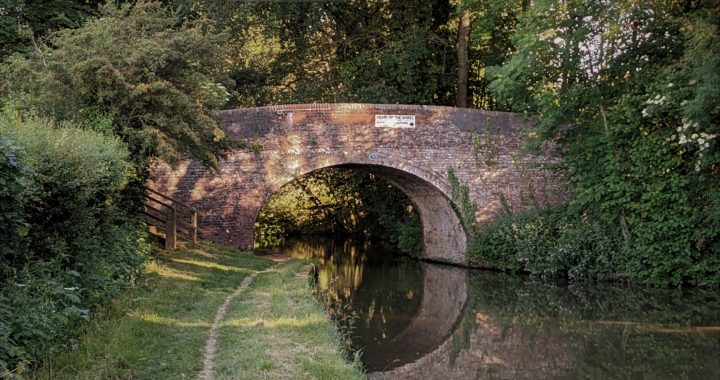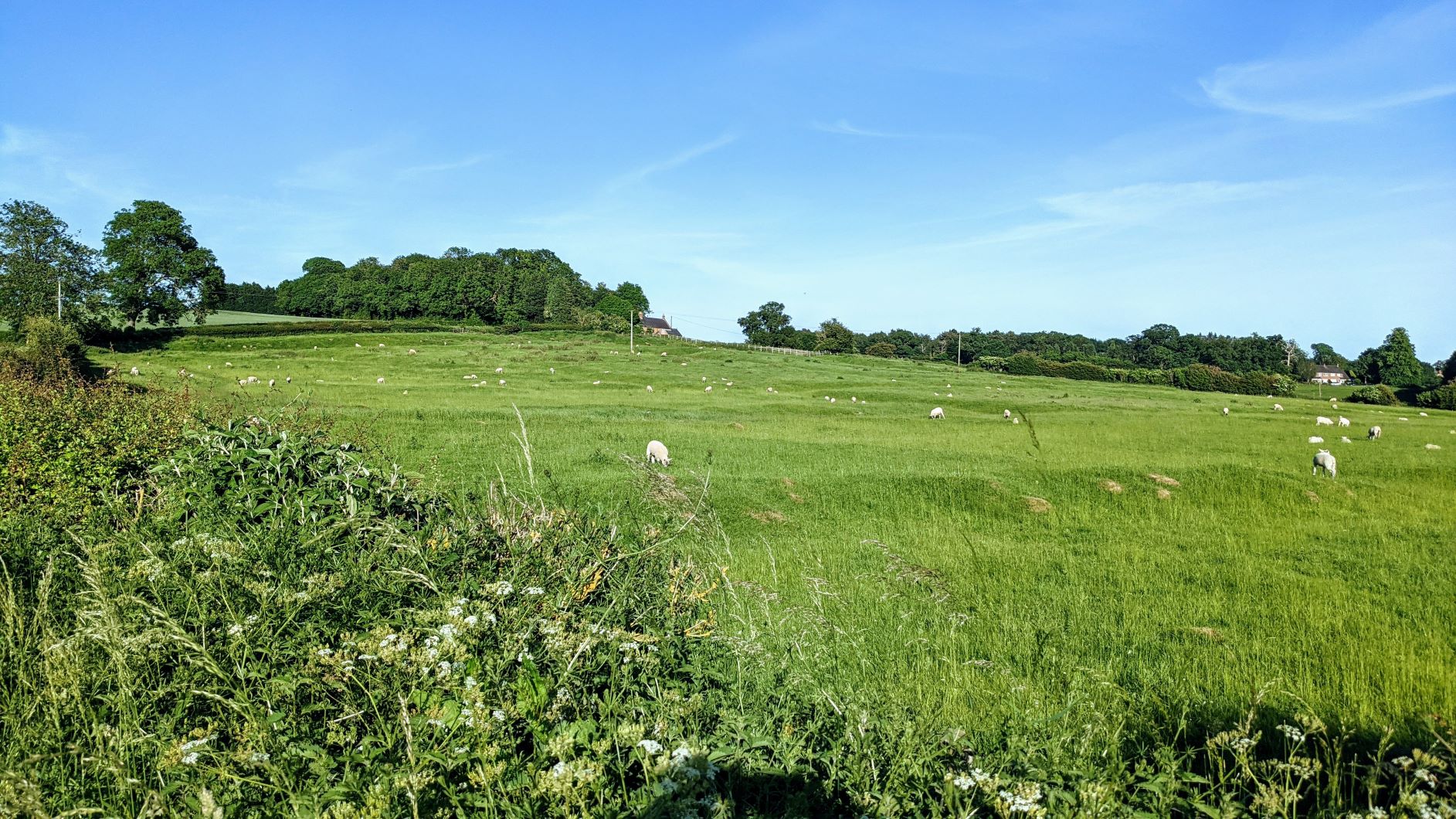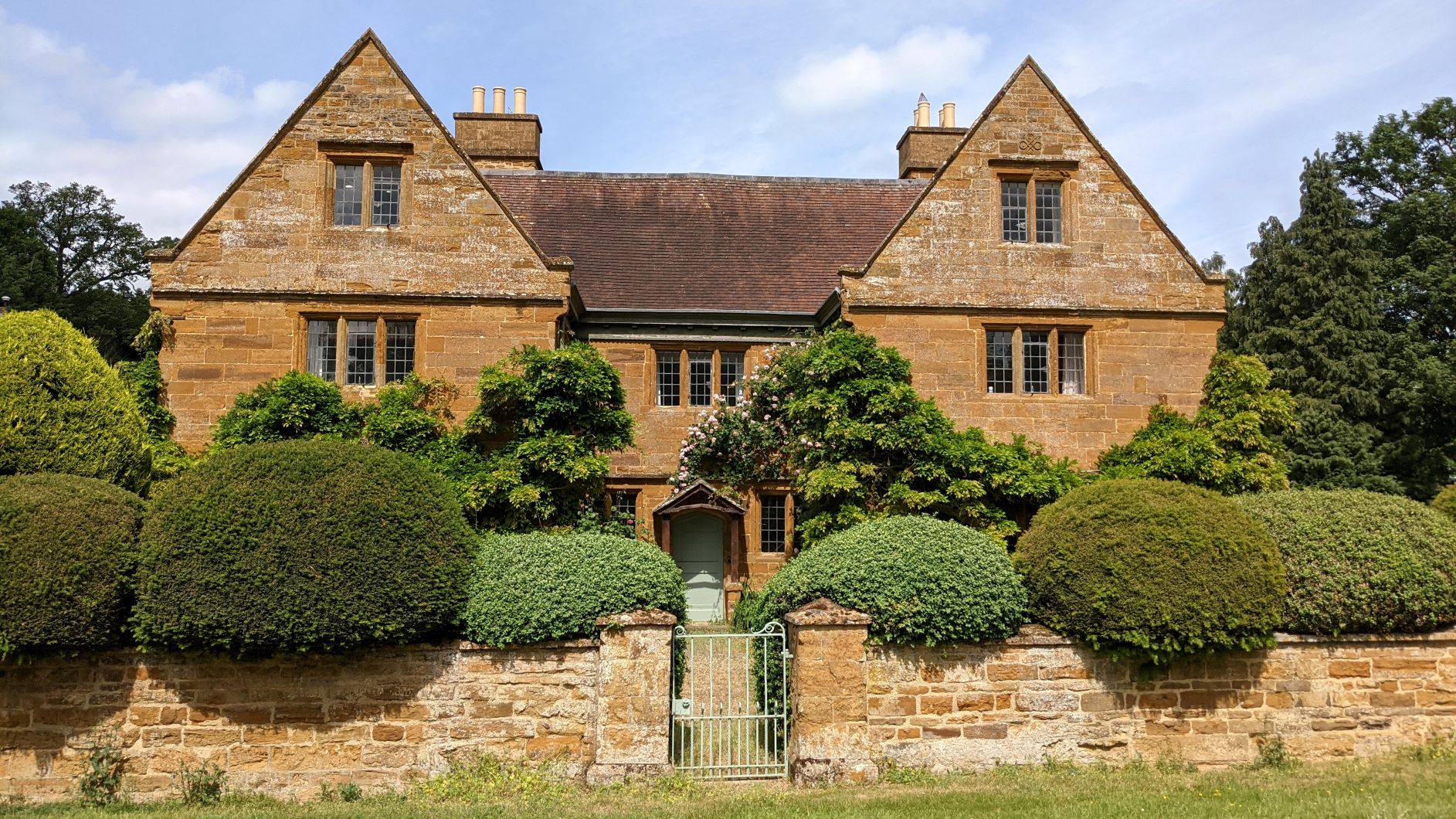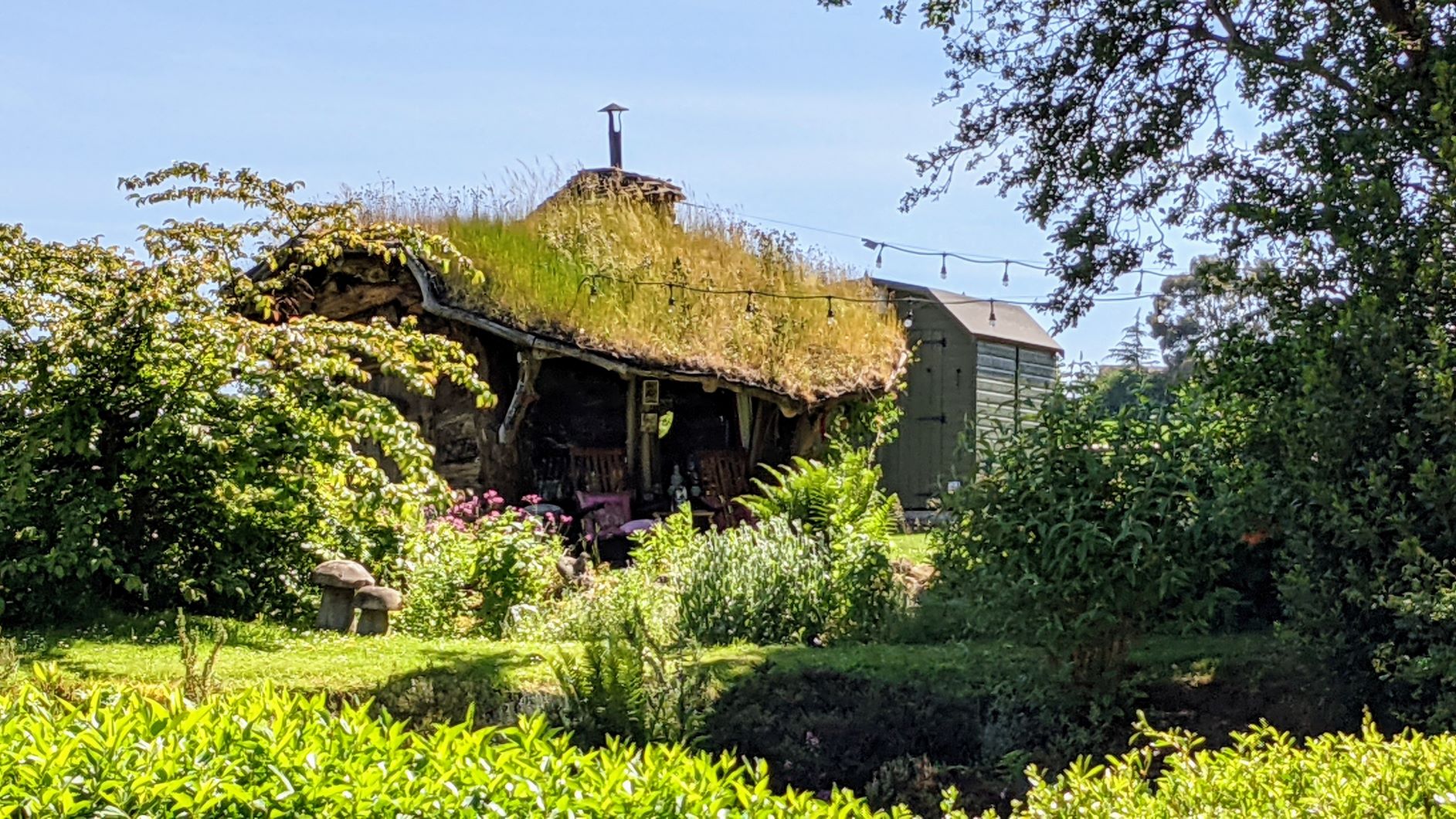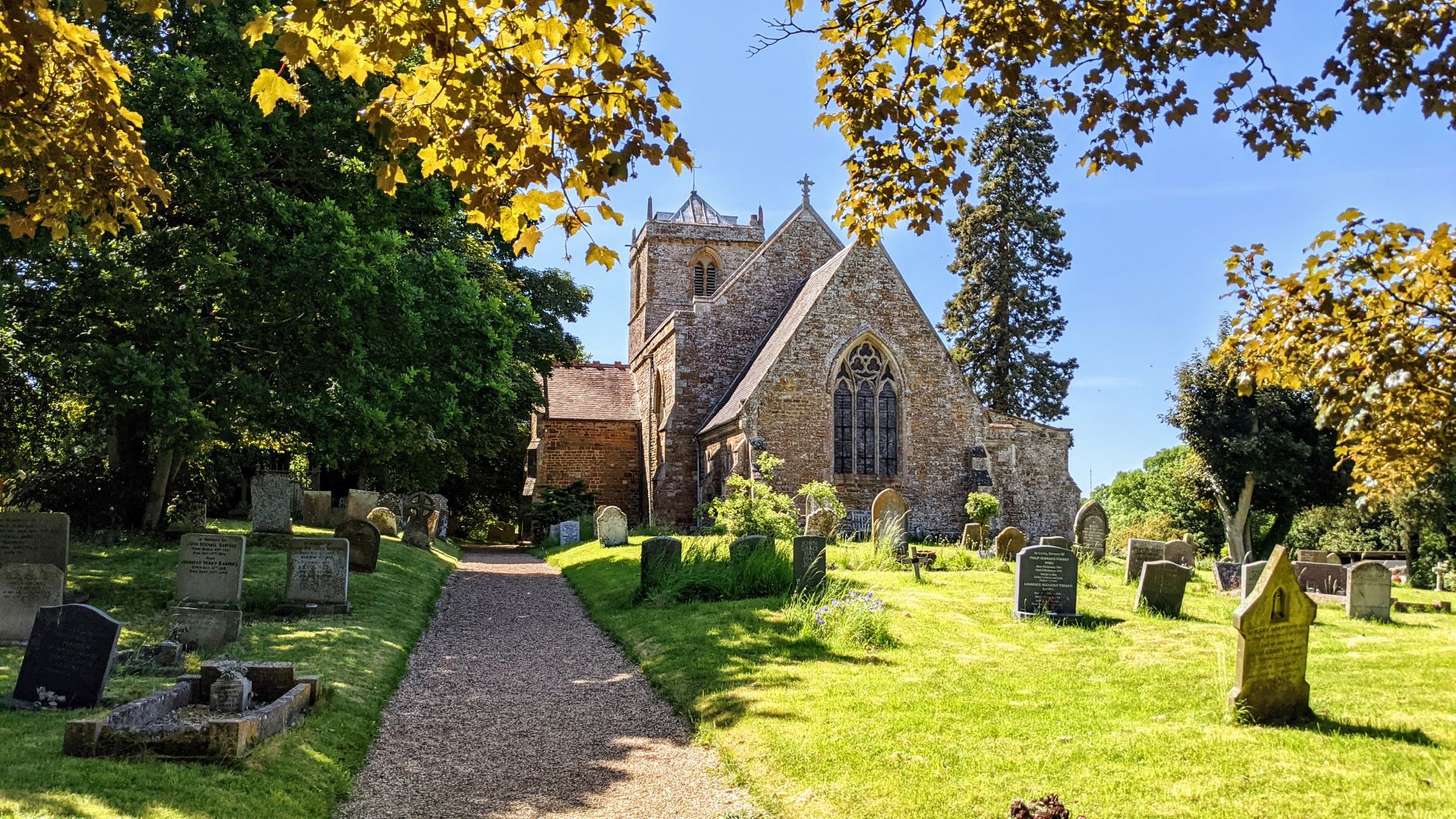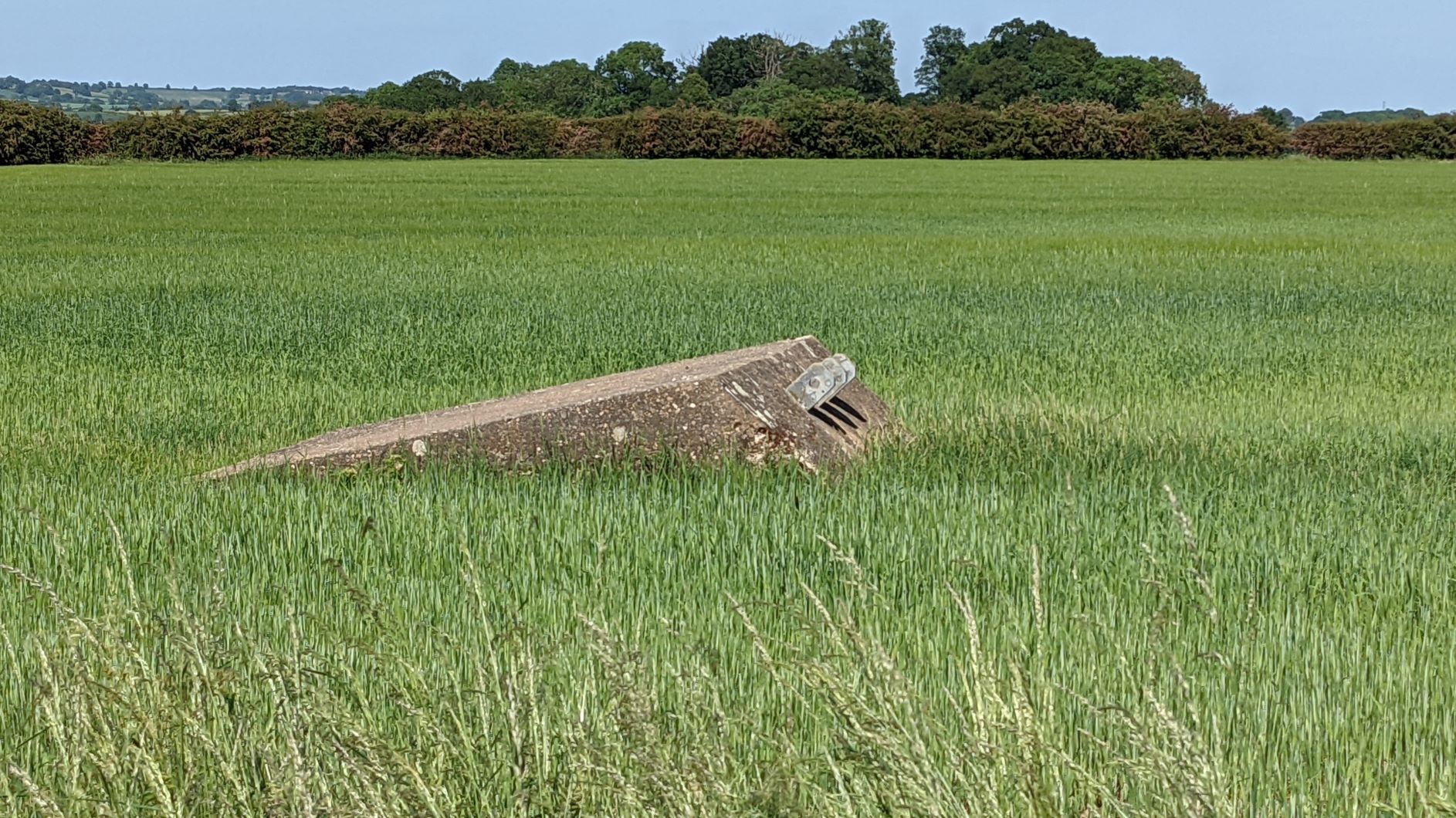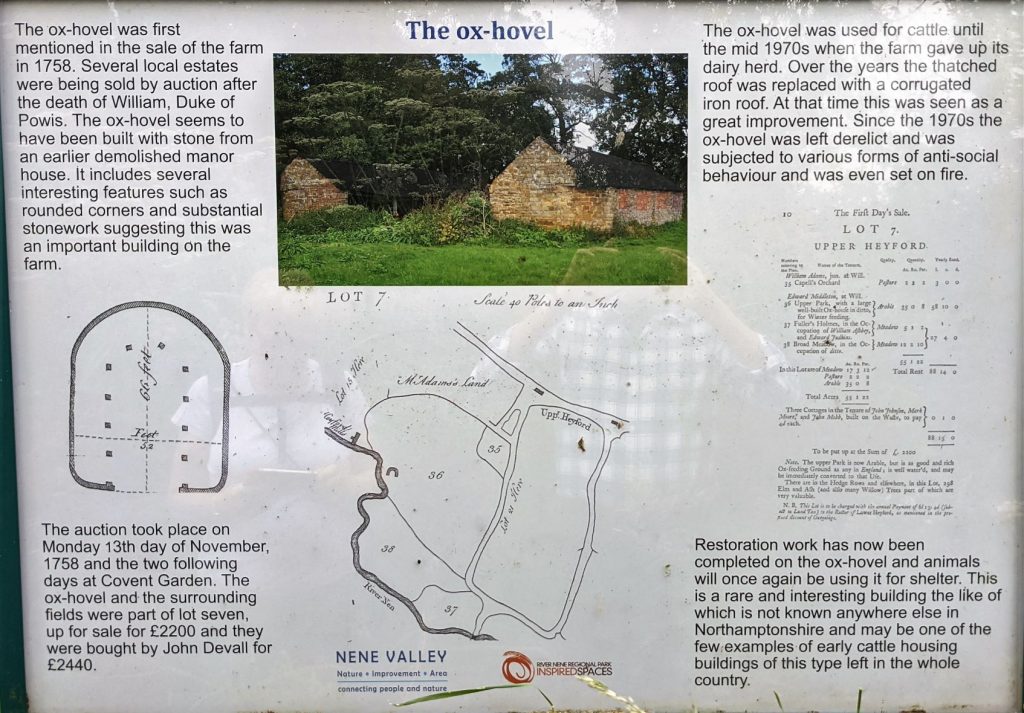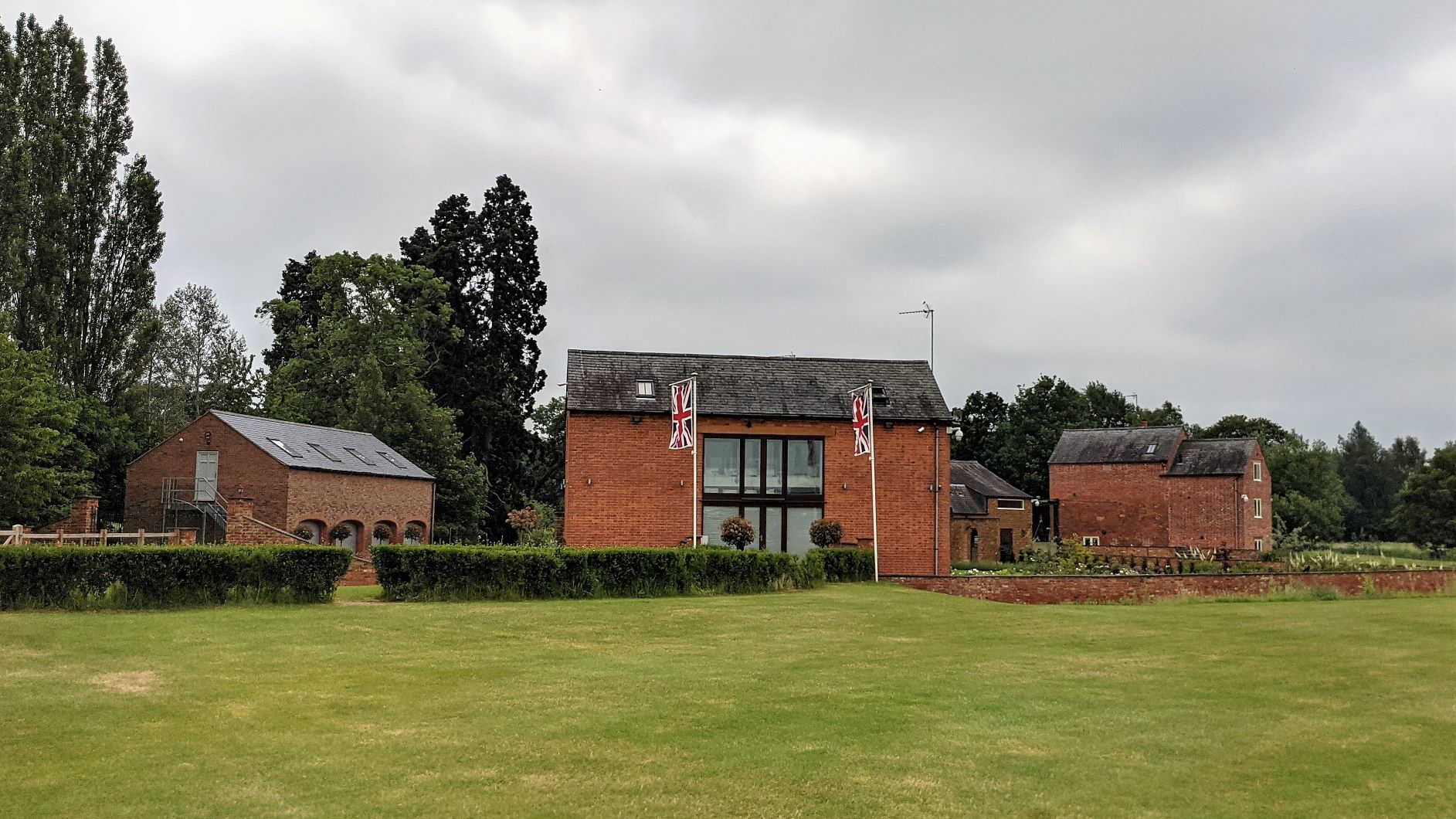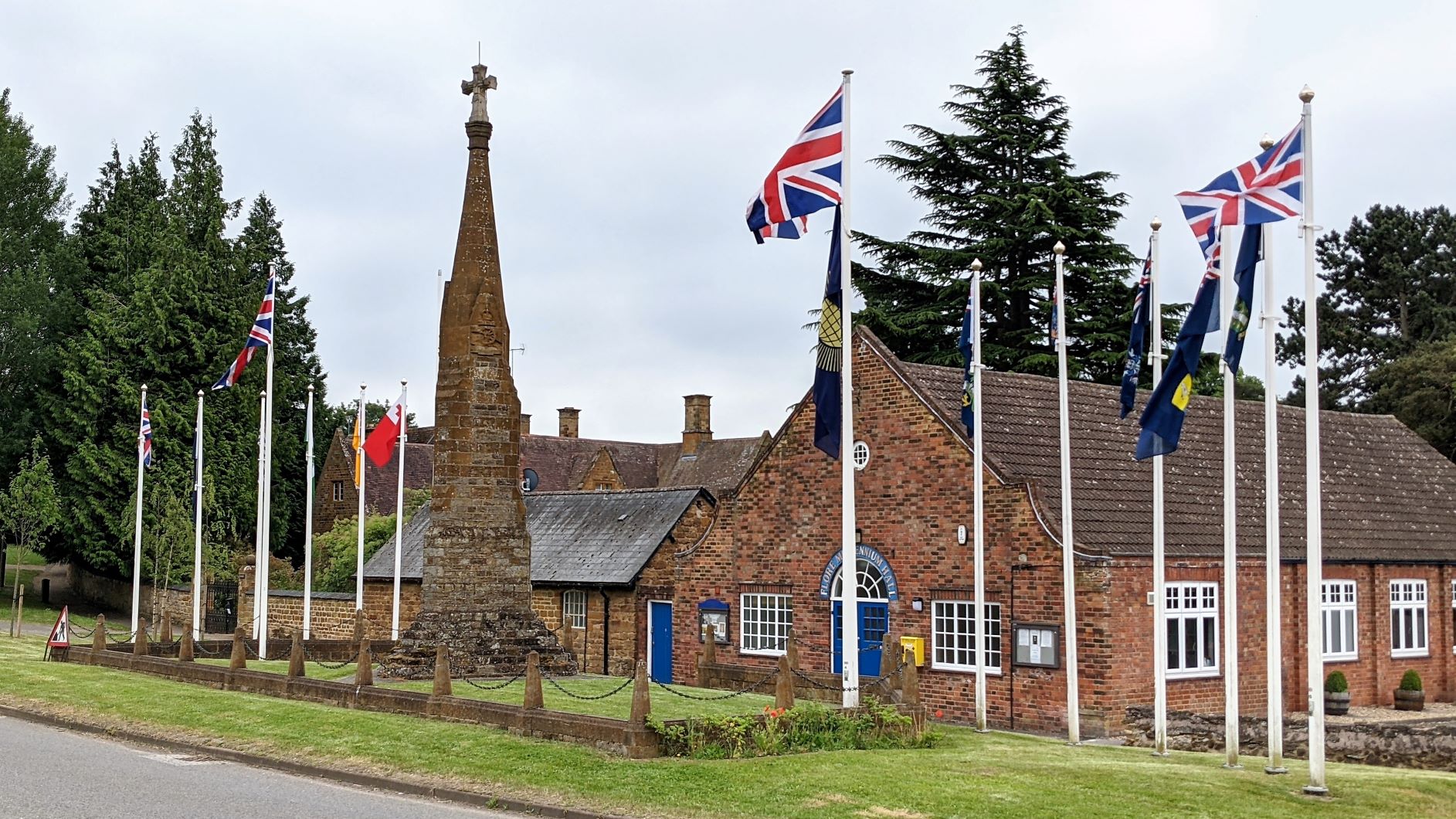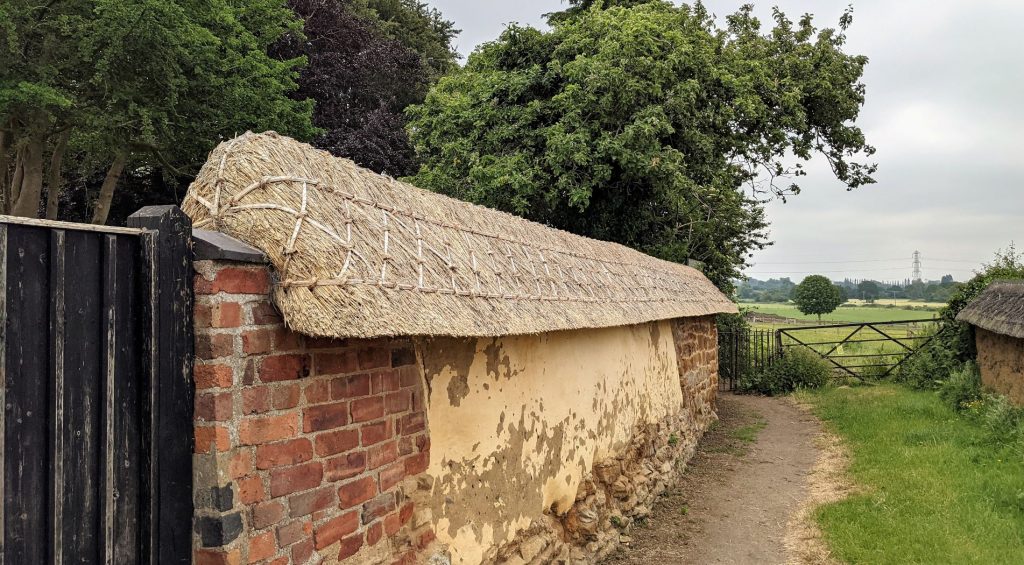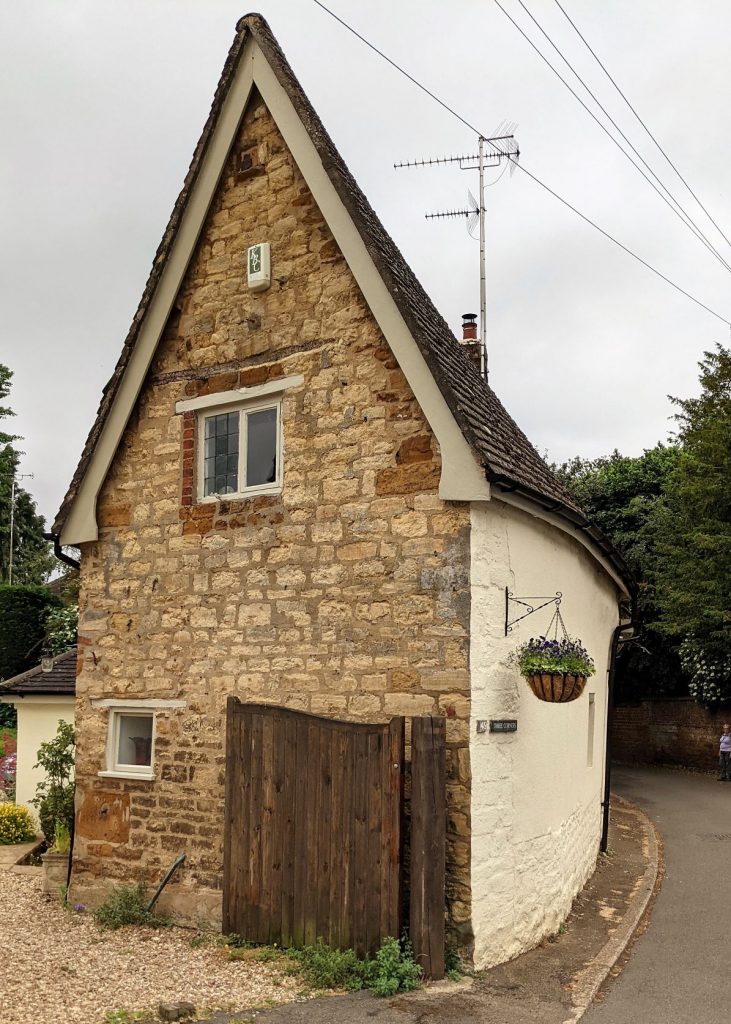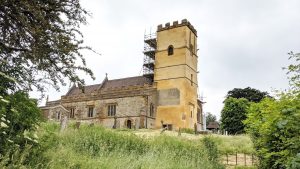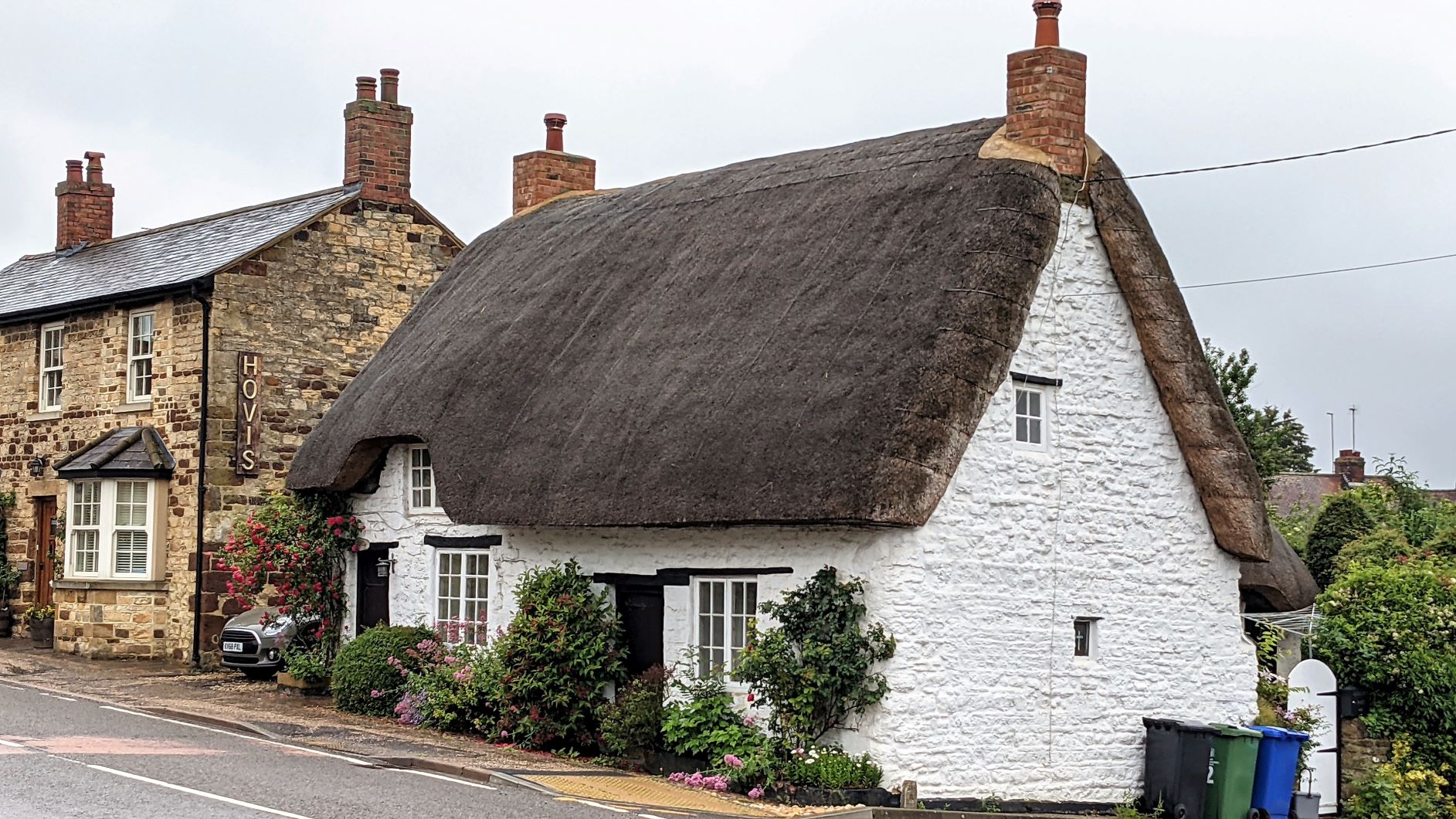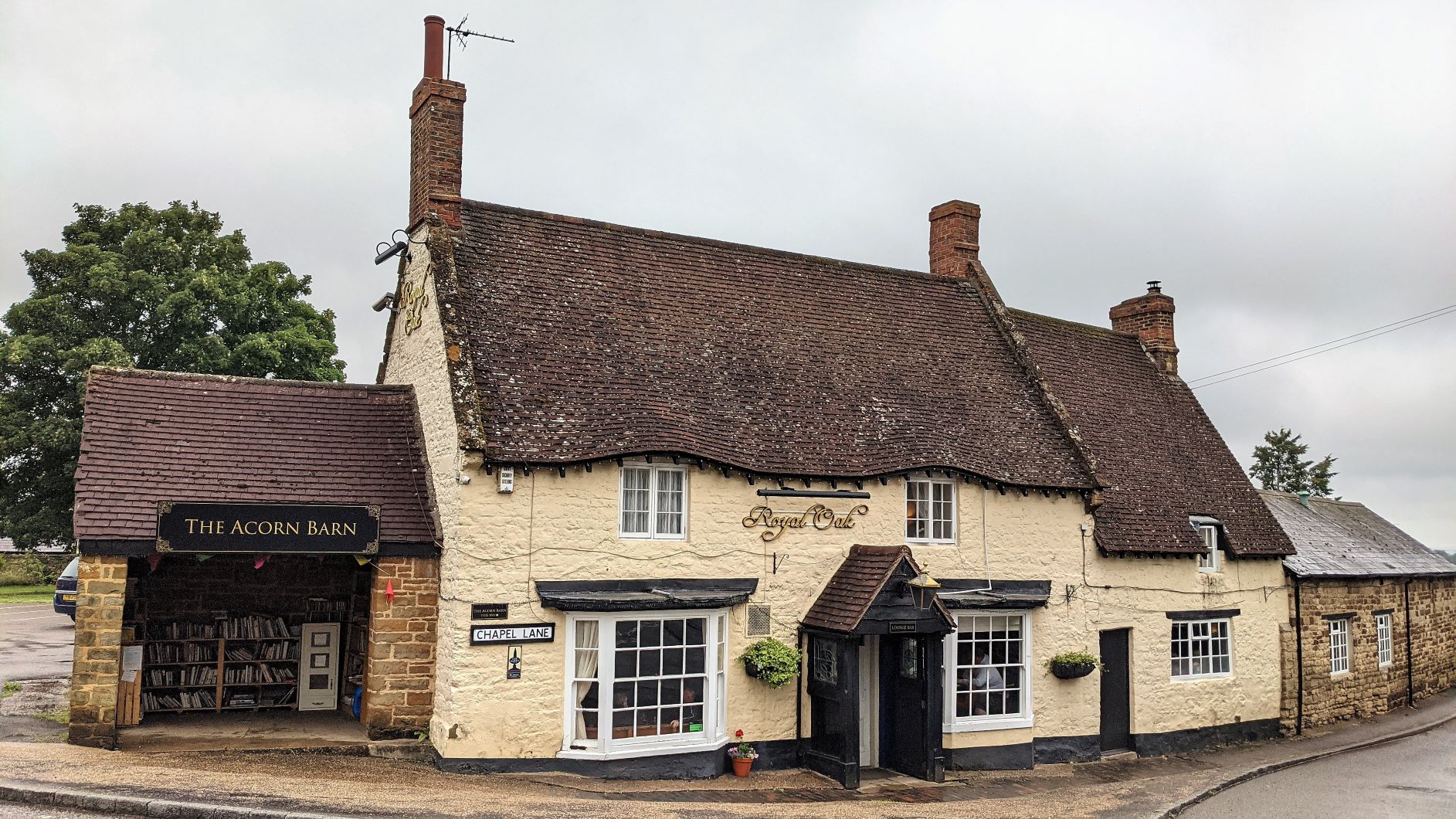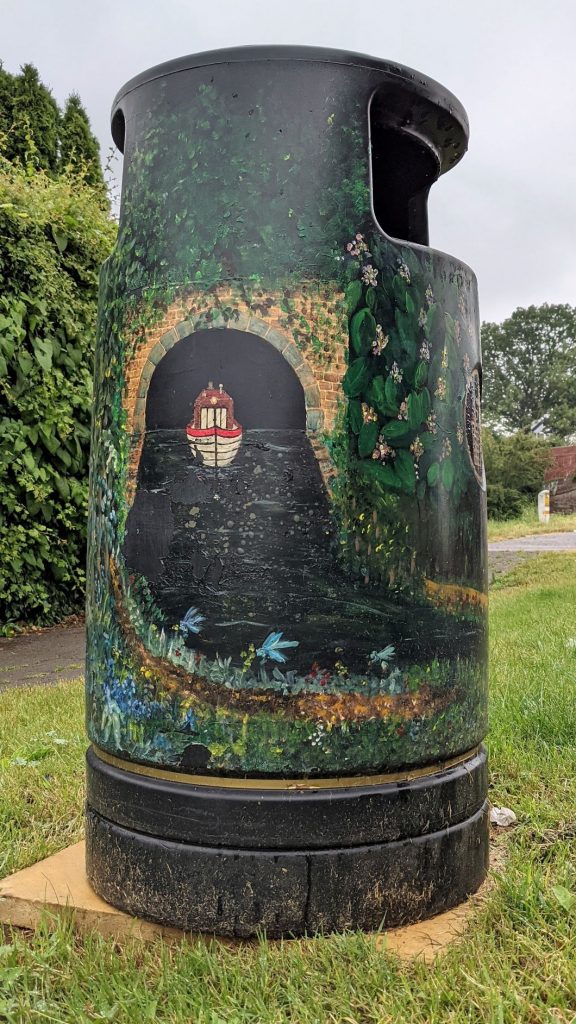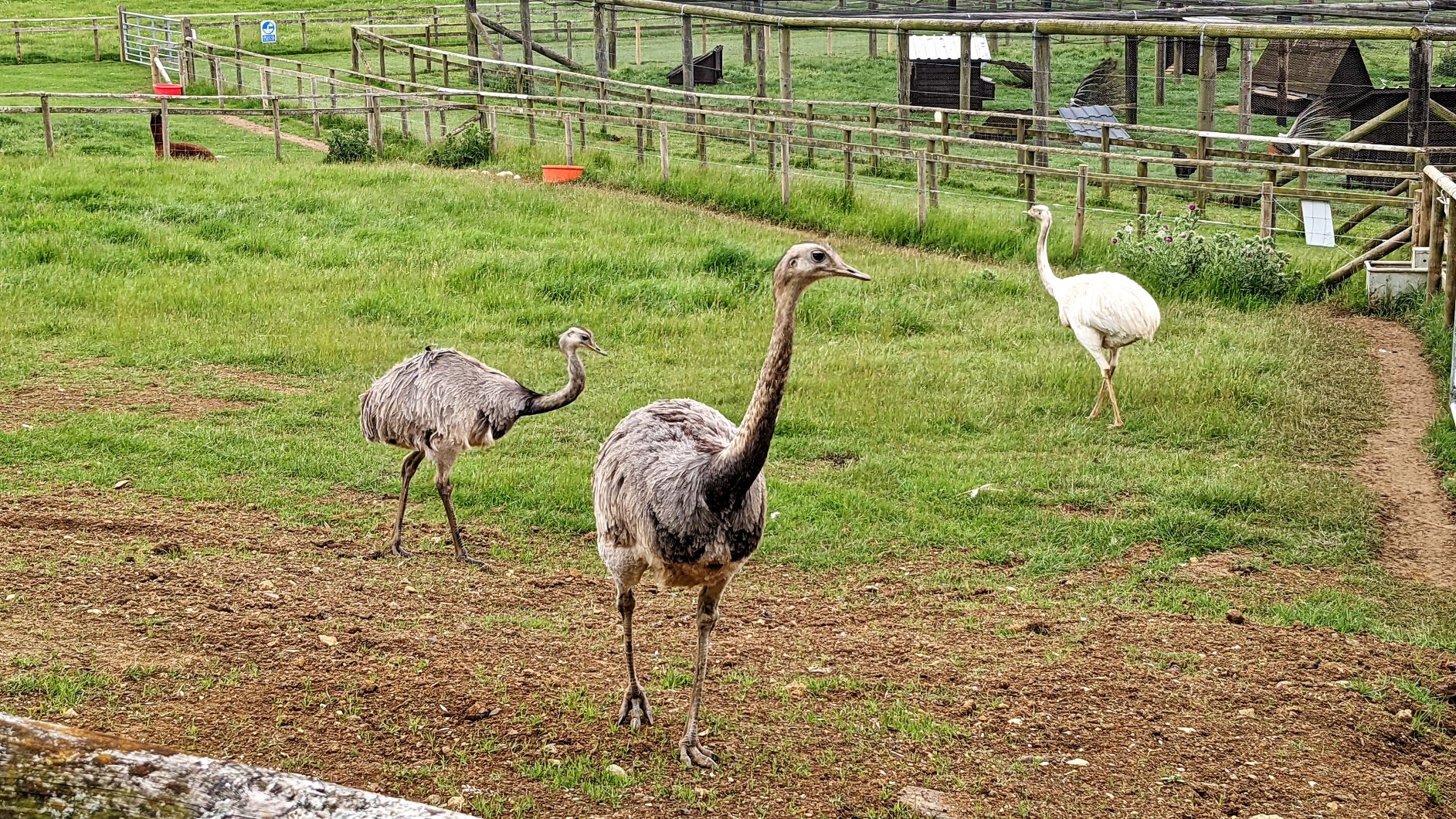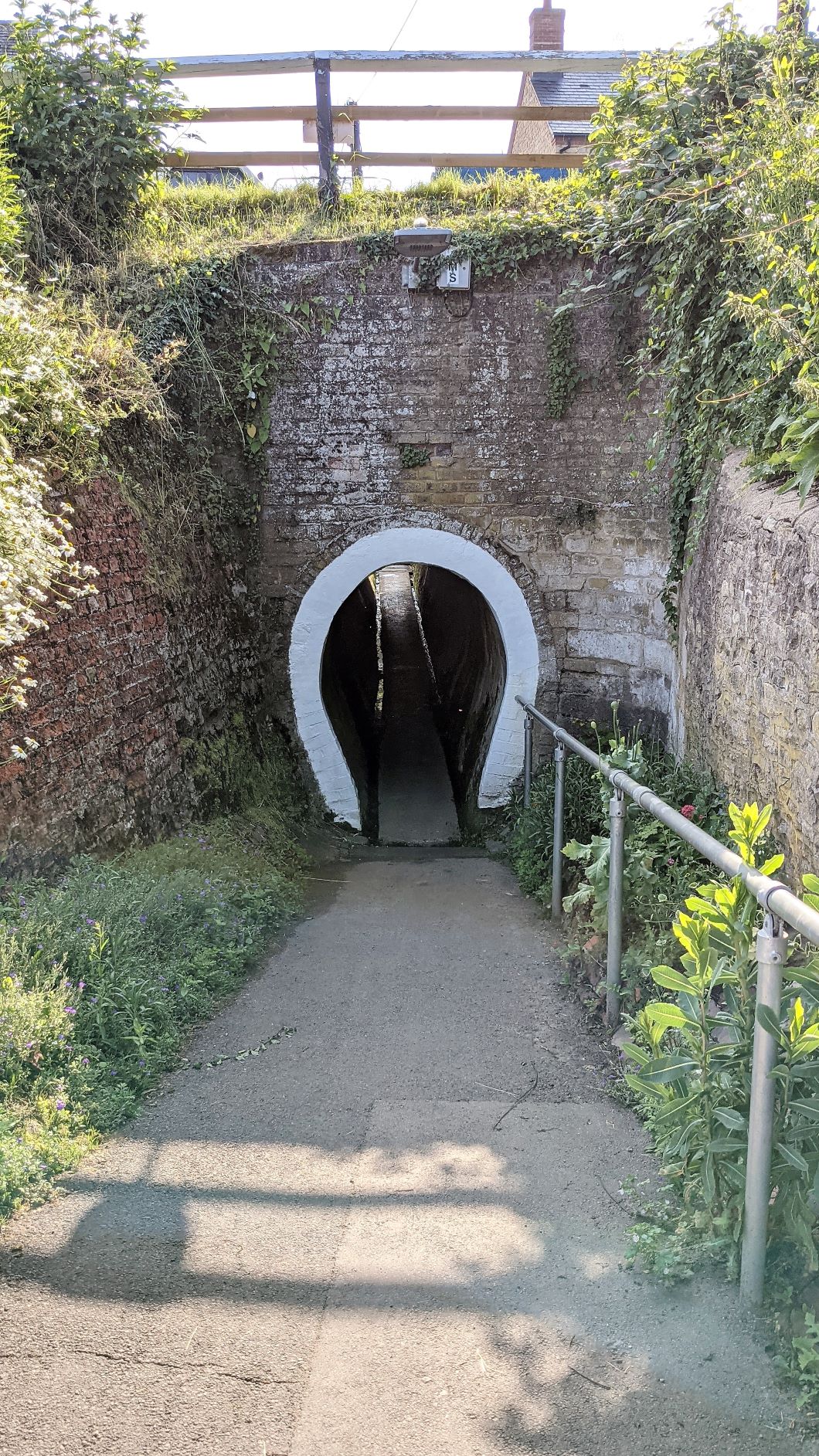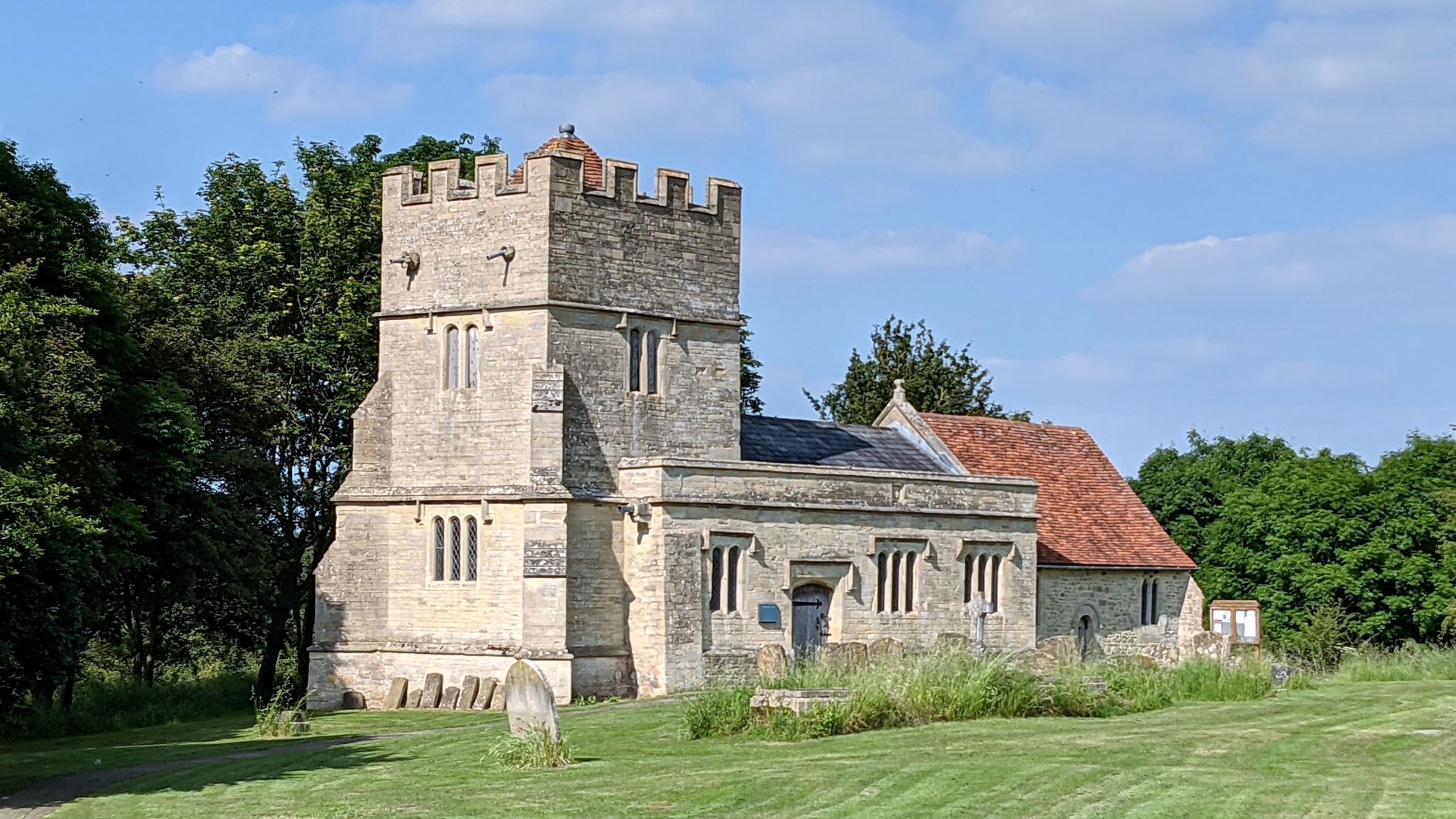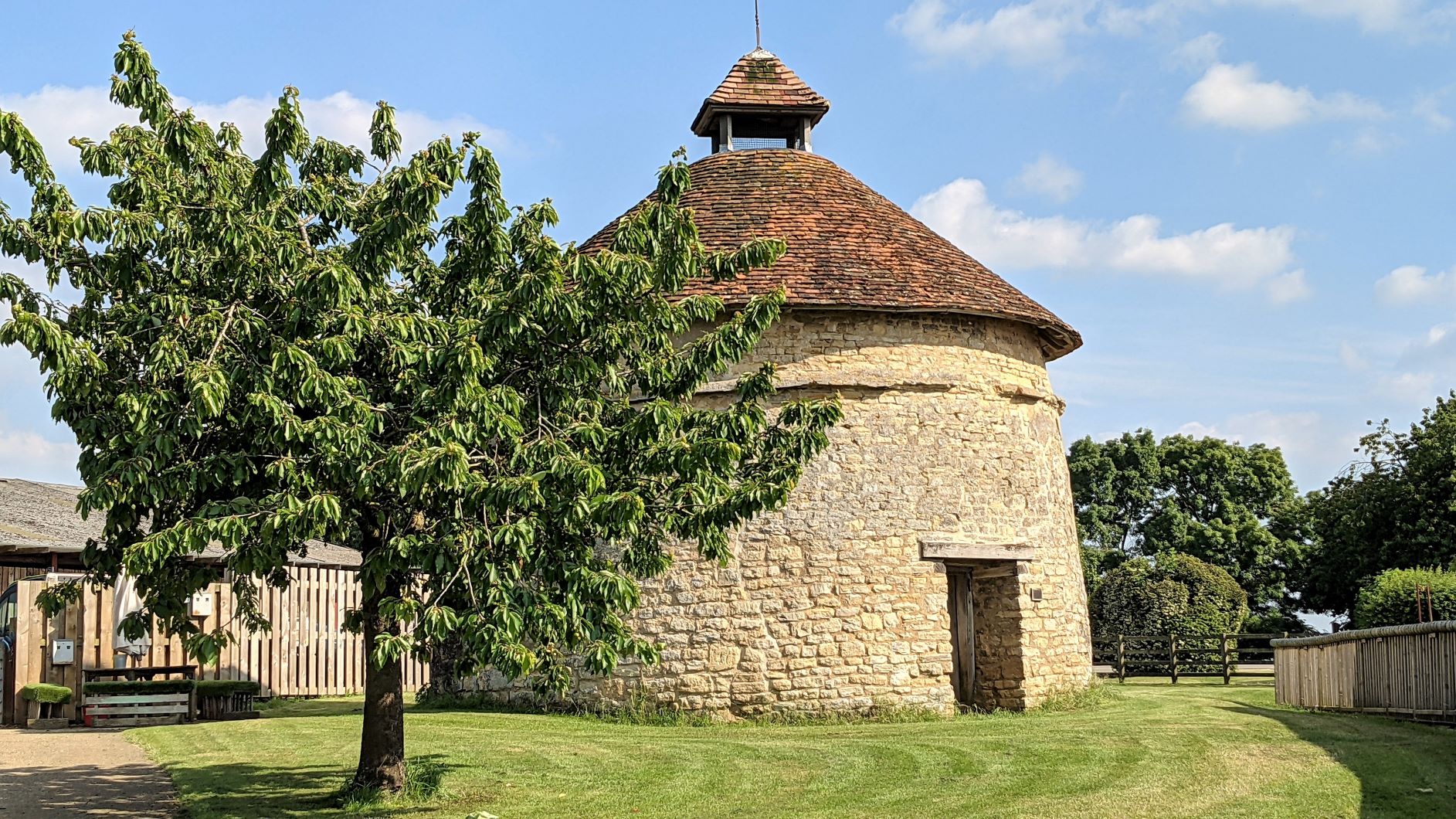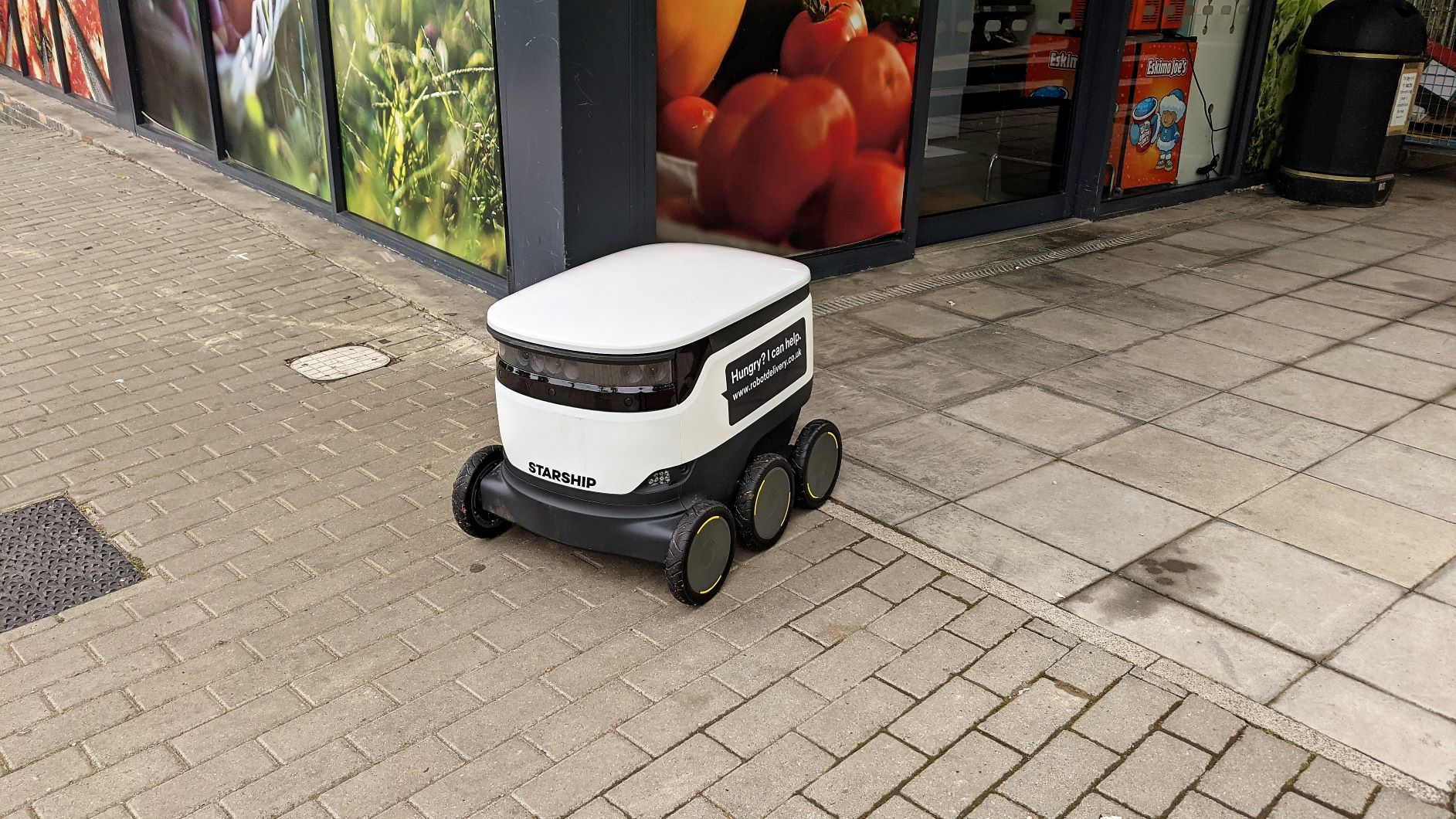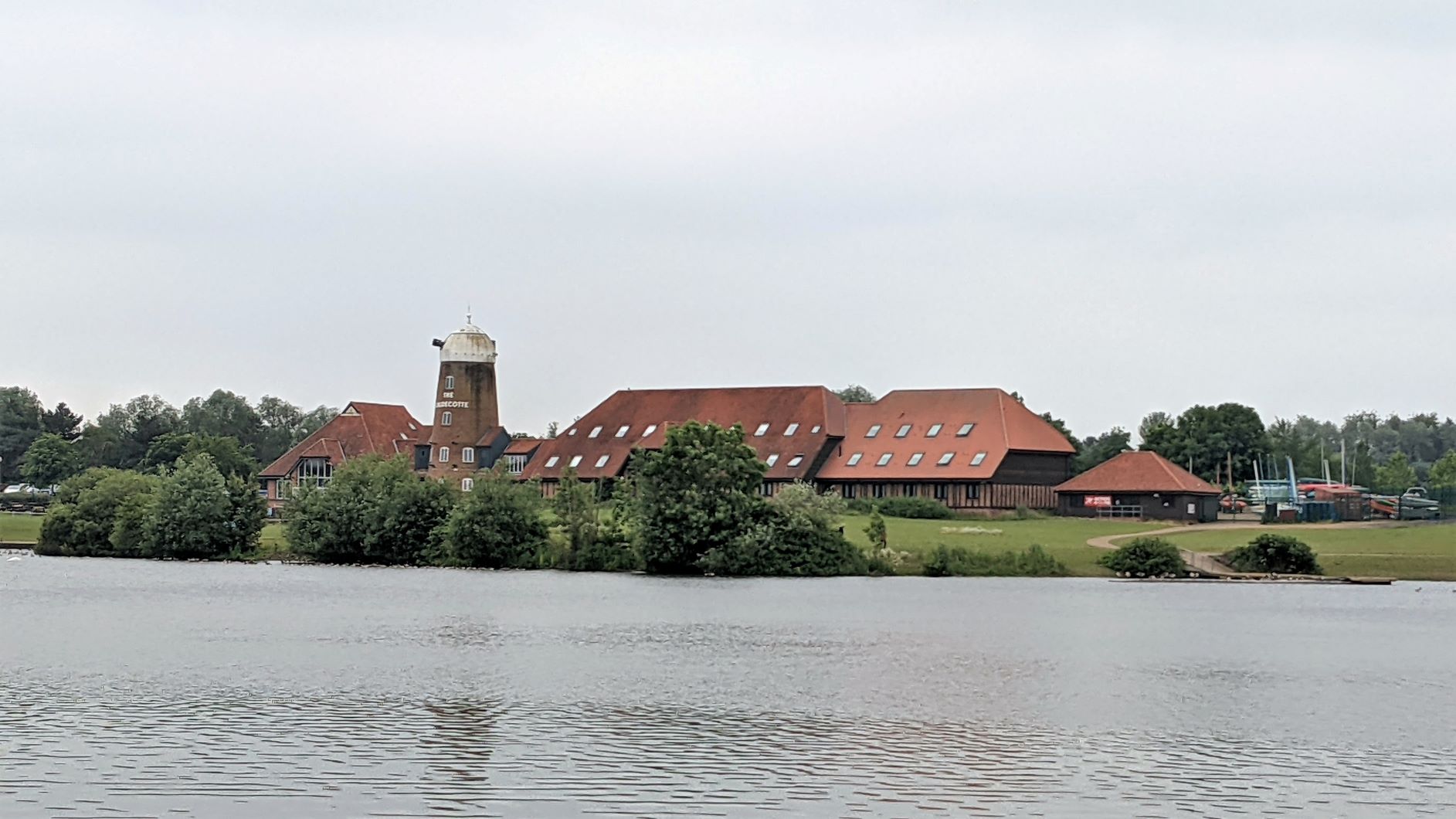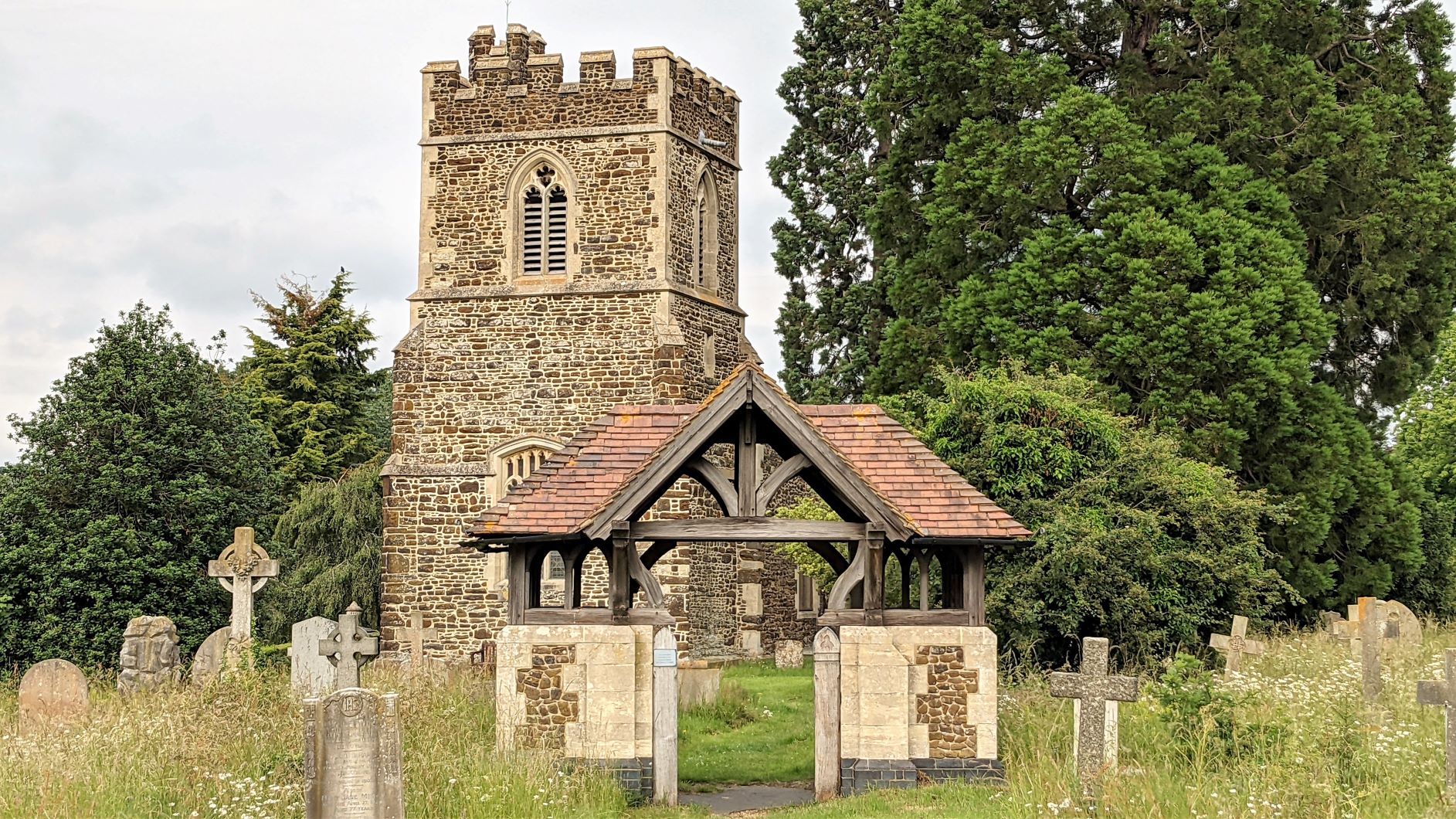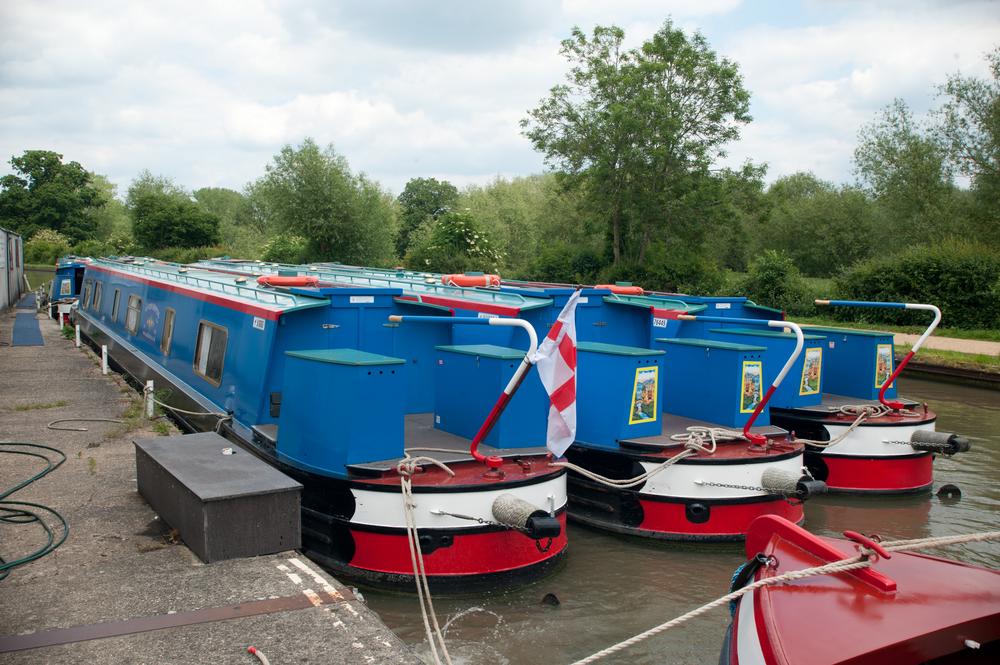Phase One
Following our new master plan, we set off on a Monday morning and descended the rest of the locks with a couple whose boat was hosting a newly engaged couple from Cambridge, so they were familiar with the journey we intended to make. Once through the locks we moored up soon after by the Heart Of The Shires shopping village. This seems to have survived the great unpleasantness and the café there has gone from strength to strength with new covered seating outside.
We had a mooch around the shops there but also took a walk up to the site of the medieval village of Muscott. There isn't much to see but you can make out the pattern of streets in depressions on the ground.
We followed this round through a place called Brockhall, which turned out to be very pretty and beautifully maintained.
We also went and had a look at Dodford, which wasn't quite so pretty but pleasant enough and seemed to have a more active population. There were a lot of cars parked outside the school there.
Coming back we came across some strange concrete structures in the fields, just where one might suppose they wanted to plough.
We concluded they must have had something to do with defences against the German invasion in the second world war. They all seemed to point in the same direction. Being in Northamptonshire, anti-aircraft batteries seemed a possibility but it actually looked like good tank country so perhaps they marked lines of defence against a ground invasion that never came.
Eventually we moved on to Nether Heyford. The weather forecast predicted a break in the lovely weather we had been enjoying so we expected to stay put here for a while. The day we arrived was very hot and the rain forecast for the following day suddenly moved to Friday. It was greyer on Thursday but we managed a decent walk across to the village of Flore, past the restored "Ox Hovel"
and Heyford Mill, which has been redeveloped as a private estate but seems quite secretive as to what it consists of.
Flore was quite a big place with a really impressive war memorial but a lot of traffic on the main roads around it.
They were preparing for a big floral festival that weekend but we did like the thatched brick wall and this strange curved, three-sided house squeezed into a side street.
We also took in Church Stowe, whose church tower stood out like a beacon from miles around but the village had much less to offer, as far as we could see. The school was busy with Mum's waiting in their cars but there was little sign of any other amenities.
Friday, Waterloo Day, was rather different to the long hot day in Belgium in 1815. The promised rain arrived in spades keeping us largely confined to the boat but it did give us lots of time to refine the details of our latest plan.
I also checked the water level in the batteries, score one for the pram cover that keeps the engine bay warm and dry. These special deep traction batteries have real advantages but one thing I hadn't been aware of until I saw some article on Facebook is that they tend to dry out more than standard lead acid batteries. When I did the 1,250 hour service I had added several litres of deionised water. A couple of weeks later I found myself topping up with another half litre. This is not a problem as such, the only issue is that access to check and top them up is really only intended for a dwarf trained as a contortionist. It takes firm discipline and an iron will to force yourself to go through the pain as often as you should.
The rain passed and left the next day cool, grey but dry. We moved on to Gayton junction, where we would eventually turn up towards Northampton. Today, after a very smooth reverse turn onto the Customer Service Facility there, we moved on to moor near Blisworth for a day or two. The rain was back overnight and after a break for the morning settled into a steady drizzle for an hour or two. We walked up to the intriguingly named Milton Malsor where we found the obligatory church and the very welcoming Greyhound pub. Warm, dry, good coffee and complimentary cookies.
Leaving there we set off across to the village of Blisworth en route to the boat. We had to walk through a lot of waist high vegetation that was soaked from the rain, which was miserable and found an extraordinarily well engineered, three storey, pedestrian bridge to cross the railway.
It seemed a bit overkill for the occasional rambler and from the top we could see at least two more. It seems to be a high speed line and we guessed health and safety dictates that the old fashioned approach of a few timbers across the line and some warning signs were no longer sufficient.
We walked around Blisworth and it seemed a nice enough place. There is a huge blister of development to one side of it but the village centre is quite attractive.
Unfortunately, two busy roads run right through it and the volume of fast-moving traffic makes it difficult to appreciate. There is a small book exchange in a little enclosed space that forms part of the pub. This is not that unusual but Blisworth goes one better. Their exchange includes unused toiletries and any food that people don't have a use for, including a cold cupboard for milk and other perishables. It seemed to be well maintained and actually used for its intended purpose.
Blisworth also had some very nicely painted litter bins by the canal.
The Longest Day, Monday 21st June, started a bit brighter than the last few days and we got going through the Blisworth tunnel, dropped down a couple of locks and moored up in the long pound there. It stayed dry in the afternoon while I went and explored Ashton and the outskirts of Roade. There was not much of note in Ashton but heading back into Stoke Bruerne, I suddenly found myself walking beside fields of alpacas, peacocks and rheas.
This turned out to be Rookery Open Farm and apparently you can pay £7.00 a head to visit it if you don't happen to follow the public right of way. The rain started just after I got back to the boat and became heavy overnight, not what one hopes for from the Summer Solstice but we've seen plenty of pictures of people wading through the mud at Glastonbury over the years, so perhaps it is not so unusual.
First Lockdown . . . Now Locked Out!
Fortunately, the rain passed overnight for a dry if somewhat cloudy and breezy day. Just as we prepared to leave the boat, Sue shut the bathroom door, there was a clatter inside and she found she couldn't open the door at all. We were in the back half of the boat. We couldn't walk through the walk-through bathroom, the front doors were locked up tight with the Yale latch on and we began to appreciate just how secure the boat was. Drastic solutions were considered but with little to lose, we decided on one more attempt at that bathroom door with a bit of brute force. Happily, that dislodged the obstruction, which turned out to be a length of trim from the pipe trunking along the wall just inside. It had come loose and dropped down and was exactly the right length to jam the door against the cupboard opposite. It is now firmly nailed in place!
With that we were able to go and have a look at Shutlanger. An interesting name and once there was a monastery there but very little to see now. We were able to come back round the route that would have been taken with the horses as the boats legged it through Blisworth Tunnel. I thought that we would see some evidence of the tunnel, perhaps a line of ventilation shafts, as we crossed over the top of it but it was virtually invisible. Maybe a slight rise in the ground was an indication but it is hard to be sure.
Wednesday was a really nice, sunny day as we carried on down the rest of the Stoke Bruerne Locks and on to Cosgrove, where we found a mooring just by Solomon's Bridge and convenient for the Barley Mow, which we visited for a drink and an evening meal. No visit to Cosgrove is complete without a shot of the horse tunnel under the canal which you need to take to get to the pub.
I found a walk round to a tiny dot on the map called Furtho. This turned out to be a lovely spot which is now offering itself as a wedding venue as well as being a working arable farm. There is the site of the original mediaeval village beside Furtho Manor Farm, which has small 13th century church and a fifteenth century dovecot in its grounds, beside a lake.
It is obviously open to visitors in normal times but it is beautifully neat and well-maintained and looked idyllic in the sunshine.
A Grocery Run & The Electric City
Thursday was a big day. Leaving Cosgrove we would pass through Wolverton where we knew there was a large Tesco and other stores. There is a convenient wharf to moor up in the middle of some flats, which is fine for a shopping stop but not somewhere we would want to stay overnight.
As well as being our first trip to a supermarket for nearly four weeks, there was also a laundromat we could use to tackle the heavier washing like towels and bedding rather than place that burden on our small on board washing machine. It would also be the first test for the new collapsible trolley we had acquired to help with carrying the shopping.
The trolley test went well overall. The first step leaving the boat was to climb a steep stairway up to the bridge across the canal and more steps to get up to the street level. Tesco also sat thirty feet below street level and was designed entirely for car traffic, so it was a long way round to avoid the stairs. Despite those inconveniences we were able to transport far more stuff in one trip than we could ever have done just carrying bags.
I spent a happy hour in the laundromat, slowly suffocating in my mask in the hot steamy atmosphere, while Sue was doing the shopping. We were all done in a couple of hours and pressed on to moor at Joan's Piece, just past New Bradwell. We went for a circular walk around Stantonbury Park and back along something called the Swan's Way to Bradville, a suburb of Milton Keynes and New Bradwell, which seems much more established with a lot of nineteenth century terraces beyond and below the canal.
The boat happened to be moored ten minutes walk from an Asda supermarket so we called in there as that was an opportunity to try and fill in some gaps Sue had found on the Tesco shelves. As we came onto the road we could see something in the distance like headlights but on the pavement. It didn't look like anything we could recognise so we waited to see what was approaching. Whatever it was, it was either very small or very far away.
It turned out to be both; a small white robot, presumably delivering a takeaway meal. It didn't look very efficient as it struggled up the hill towards us, stalling for a moment, then surging forward then hesitating again as if slightly confused. It would be interesting to know how many of these deliveries arrive at their destination with their contents intact. To us they seemed extremely vulnerable.
The next day started out rather dull as we moved up to Milton Keynes where, on arriving at midday, we found the two day visitor mooring completely empty. The sun started coming through as we moored up and it turned into a bright, sunny afternoon while we made our way up to the shopping centre, twenty minutes walk up the hill. We had a few errands in town and we also had an appointment for a Zoom meeting with Mike & Lesley Fielding and Neil & Karen Payne scheduled at about half past three. We went equipped to do that from the precinct if we had to, although it would obviously be easier on our own boat.
This was another exciting day, even if we did have to wear masks in the mall. We had lunch at Costa, did a deal for a data SIM card on a backup network, collected an Amazon delivery from Budgens. As it seemed Tesco and Asda had still not been able to fulfil all our requirements the previous day, we even went to Sainsburys. All a bit of a rush but we made it back to the boat in time for our meeting.
While out and about we had come across another of the robot delivery vehicles, waiting patiently outside Budgens and we remembered to take a picture this time.
We also noticed the number of electric scooters around. With a little investigation it turned out that three separate companies were carrying out authorised trials of schemes to make the scooters available on a pick up and drop basis, similar to Boris bike schemes around the country. We guess Milton Keynes is a perfect place to conduct these kind of trials. There are miles and miles of very well made up paths and cycleways all over the area and connecting all the different communities across the open spaces that are provided between them. It also doesn't seem to be the kind of area where you could guarantee the equipment would simply be stolen or damaged as soon as it was left unattended.
We stayed on here for the next day. Sue took the opportunity to go shopping unescorted while I had a look at the new marina that has recently opened and explored the area on that far side of the canal, which we had not previously really visited. There is an amusement park there, which you can hear from the towpath but beyond that Willen Lake is huge and caters for every kind of water sport activity with ski ramps, zip wires and water parks
and all around it are huge areas of wide open space and public access park land, all managed by the Milton Keynes Park Trust As we have noted before the way the considerable amount of housing created here disappears into this complex green backdrop is very impressive.
I took the opportunity to try out one of the electric scooters. You sign up online and supply a payment method. Then you can use their app to locate any of their available scooters nearby. You can reserve one for ten minutes while you walk to it and then just ride it away to your destination, then leave it there, sensibly parked for the next user. You can take a photo of where you have left it that the next user can see to locate it easily. Apparently a crew goes around at night locating machines parked in unlikely spots and getting them recharged for the next day. There are a few rules about where and how you can ride or leave them but nothing very complex. You get charged a flat fee plus so much a minute for the ride.
The first one I tried appeared to be faulty. I didn't know exactly how they were supposed to work so it took me a few minutes to reach this conclusion and cost me £2.30, which I could have but couldn't be bothered to, claim back. The second pair I went to were actually still in use. The riders had used them to get there but booked off to avoid paying more charges. However, they were sitting there with the scooters beside their bench, just talking and clearly intending to ride off on them when they were ready. The third machine was where it was expected and unoccupied but actually showed it had a fault. One more try and I finally had a working scooter I could take possession of and try out! It was great fun. They get up to about thirteen miles per hour, they ride well on a smooth surface and have good strong brakes. However you need to be careful with the brakes in relation to the speed you are travelling at. I had a good fifteen minutes for a couple of quid and would easily have got from the canal to the shopping centre and beyond to the retail park in that time.
As a way to spend an hour on a sunny Saturday afternoon it was very diverting. My own conclusion on the experiment, though, was that they shouldn't really have a future in a general setting. The machines are heavy and can get up a really fast pace, three or four times walking speed. In crowded, shared space I think that is asking for trouble for all those around them as well as the rider. If there are kerbs and multiple roads to cross, with traffic, they will become awkward to handle and if the ground is not nice and smooth it won't be an easy ride. They don't come with helmets so if people are to jump on and jump off impromptu they won't wear one and the pedestrians nearby can't be expected to. In a truly urban environment I can't believe that the loss rate through theft and damage would be sustainable. By choosing to trial these in Milton Keynes they are loading the dice for a potentially successful outcome that then simply won't translate elsewhere. There are few places in Britain that have such a network of smooth, empty ride-ways and it is not a scenario that can easily be recreated within an existing urban or industrial landscape.
Leighton Buzzard & Beyond
Moving on to Fenny Stratford on Sunday morning we found there was very little room at the inn. We managed to squeeze into a one day visitor mooring just before the lock. That was in front of an old work boat and behind a small plastic cruiser whose owners were having a drink in the sunshine. The space was only just long enough to take us and the cruiser crew looked distinctly nervous as we wrestled our eighteen tonne narrowboat into it. The rusting CRT barge was just left in the middle of the mooring space. You have to wonder why they would clog up a restricted mooring space for visiting boaters with their maintenance craft. We were told that, far from twenty-four hours, it had been there for weeks, which adds insult to injury.
We managed a nice walk back to a place with the unlikely name of Simpson and all around Lake Caldecott
before returning to Fenny Stratford and popping over to The Red Lion for a drink. We remembered the pub as looking a bit drab and run down but it seems to have had a refresh during COVID and is now really quite pleasant.
Leaving the next day we went straight into the lock, which is distinctive in having a swing bridge sitting right across the middle of it. This was open when we went in and as we left I needed to shut it. There were instructions on how to do this at the business end of the mechanism, which I studied. After a couple of minutes of fruitless pushing and shoving a lady, living in the cottage right beside it, came out and pointed out that at the far end of the moving bridge section there was a catch that had to be disengaged before it would move. This wasn't mentioned in any of the instructions, although I really should have remembered it from previous passages. The lady wished that she had a pound for every time she had had to point this out but I sensed that, secretly, she enjoyed the chance to interact with people going past and be useful to them.
Once finished with the water etc. at Fenny Stratford, we were aiming for Soulbury Locks with a diesel stop at Willowbridge Marina, which has a convenient service wharf on the canal side, on the way. In practice, "Nightingale" went through just before us so we had a bit of a delay loitering in the lock, waiting for them to finish and chatting. Then Willowbridge had a hastily scrawled cardboard "out of order" sign hanging over the diesel pump. It seems that they had someone come to service it the previous day and they had succeeded in rendering it inoperable for who knew how long. They did have another pump for road users in the yard though. It wouldn't reach the boat but we could fill our jerry can to ensure an emergency supply. Lastly, as we left Stoke Hammond Lock on the way to Soulbury it started to rain. We almost got out all the wet weather gear and then realised that we could just pull over and stop for the day here instead.
By the time we had had lunch, the rain had more or less stopped and I noticed that we were actually quite close to Great Brickhill. This is a place we have visited several times to meet Sue's sister for lunch, being more or less midway between our respective houses. However, we had never done more than get out of the car, go into the pub, come out again and drive off, so I decided to go and see a bit more of it. One of the pub's key features is a spectacular view from the back terrace, the village being at the top of a hill. The clue is, of course, in the title.
A stiffish climb, then, from canal level but quite pleasant on the way up and overall a nice little village with almost zero activity of any kind. Coming back around, the loop ran through some very tall undergrowth, now drenched by the earlier rain, so I arrived back at the boat with sodden boots and trousers to dry.
Wimbledon fortnight having crept up on us, we settled down after tea to watch Andy Murray put us through the wringer in his first round match. It was virtually all done at eight o'clock, with Murray two sets up, when he dropped the third and it finally finished in four sets at ten o'clock. A bit more drama, really, than I needed on the first day and I am convinced that the crowd's original encouraging chant of "Let's go, Andy" gradually became a much more plaintive "Let us go, Andy", as last train times loomed ever nearer.
Tuesday stayed nice and dry, if a bit dull and we followed through Soulbury Locks and on to The Globe Inn, just short of Leighton Buzzard. One thing we have noticed, comparing this trip with the one we made three years ago on the way to the Thames, is that it seems a lot more congested, much further north. On the previous trip, as we got closer to London, we got used to seeing rows and rows of dilapidated narrowboats, piled up with filthy bits of junk and green wood, sometimes on actual long term mooring sites but often just on the towpath. We don't really remember this being very apparent until we were down near Denham and Uxbridge. This time we had been seeing the same thing pretty much since we came down the Buckby flight and more prevalent still as we reached Milton Keynes. Small groups of what we, affectionately, termed "sheds" were around every corner often grouped two and even three abreast in groups of nine or ten. The sheds were starting to form shanty towns and the implication for us was that sites that we had recalled as being easy to moor at were becoming very crowded. In this case, the moorings beside The Globe Inn were very full and we were lucky to squeeze ourselves in with some nifty parallel parking, achieved manually by pulling the boat in, from the centre of the canal to just enough space, using the bow and stern ropes together.
Once moored up we had an hour or so to follow the Green Sand Ridge path round the Great Ouzell and across to Old Linslade and back down the opposite bank.
This time it was Federer's first round on Centre Court. Expecting the whole thing to run like a Swiss watch, it turned out to be his turn to have a shaky start, before his opponent fell over and retired hurt. Two and three quarter hours to reach that conclusion, with Federer making very heavy weather of it in the second and third sets made us glad that, this time, we had chosen to watch the highlights rather than getting sucked into it live.
There followed a packed day to reach the southernmost point of this trip, where Sue would leave me for a few days to attend the hen party which had been setting WhatsApp humming for the last few weeks. Passing through Leighton Buzzard Lock, lovely tight new gates but one of the slowest fillers I have encountered, we called in at Wyvern Shipping. We have always been a bit down on this crew as, when we have come through in the past, having their fleet moored up three abreast for hundreds of yards has often caused problems with boats travelling in opposite directions trying to get through.
Today, however, every single boat appeared to be out on hire and they couldn't have been more helpful with diesel and water etc. so perhaps we owe them an apology.
Leaving Wyvern you are almost at the two hour maximum stay shopping berth right outside Tesco with the delights of Homebase and Aldi just across the car park. A big shop, to ensure I wouldn't starve, followed by a call in to the service facility for the last chance to dump rubbish and use the sanitary station and we were on the last leg up to Grove Lock. We had moored there in the past and from memory it seemed ideal but now we were starting to worry that it might have attracted a shed city and have no room for us to stop. In the end we found a space exactly where we had planned but in very similar circumstances to Fenny Stratford. At almost the last point at which one could moor before the lock was an abandoned pair of work boats breasted up. Our space, just before those and ahead of a moored narrowboat, was just big enough, with a couple of feet to spare, as long as the work boats stayed still. We wrestled ourselves in but I was nervous of the movement created by the lock emptying as boats went through so I went to have a closer look.
The barges were piled high with all kinds of rubbish from black bin bags to builders debris and old bicycles; everything, including the kitchen sink. My main concern was that they didn't seem very secure. On closer examination I found that the stern and bow lines were pointing in the same direction, which means they were always going to move back and forth several feet with any current. Also the material used to secure them was just old bits of shredded rope looped around the sharp metal railing and already badly frayed. I ended up using a couple of our own mooring hooks to at least hold them in place so they didn't surge into us every time the lock emptied. Local residents told me that the barges had been there for weeks getting fuller and fuller, that they had already broken free once and that CRT had then arrived to tie them up again. If so, they had done a terrible job.
Over the next few days I saw boats arriving alongside and chucking more stuff into the barges. Other people came on foot from miles around, pushing wheelbarrows up the towpath from wherever they were fitting out their boats, to add their contribution. One boat even turned up, winded, scavenged a complete kitchen unit door set and cruised off back the way it had come.
Having got our boat moored two hundred yards from the pub, I settled in for a few days of peace and quiet until Sue returned and we started retracing our steps back towards the Northampton Arm.

